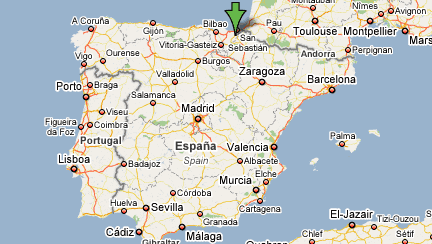
What you see here is the most famous view of San Sebastian, or as the Basque call it, Donostia. Bahia de La Concha is the sea side view while the city is cradled by the rolling Guipuzcoa hills. San Sebastian started out as a mere fishing village, mainly harvesting whale and cod fish which are staples of Basque cooking.

San Sebastian is our first stop located in the Basque country. The Basque country consists of four provinces in Spain (Bizkaia, Gipizkoa, Araba, and Nafarroa) and three located across the boarder in France (Lapurdi, Zuberoa, and Nararroa Beherea). They were well known as skilled boat makers while also specializing in cod fishing and whaling. Many citizens consider themselves Roman Catholic, this religion is by far the most practiced in this area. They also have their own unique language: Euskara which is believed to be around 3,000 years old.
One of the things to watch out for here is the dated rivalry between Basques and the Spanish and French. With the Franco Regime in Spain many years ago, Basques were disapproving of the outcome leaving behind a constant battle between the Basques and their neighbors (Buber's Basque Page). Another good source I found, take a look for more information: http://www.janecronin.eu/index.php?id=98:the-basque-country-and-eta


Basques are known for their sportsmanship, participating in several activities and events including, but not limited to: grass-cutting, log-chopping, caber-tossing (the giant tree that is around 19 and a half feet tall and about 175 pounds), tug-of-war, an intense version of handball, and even cycling!
There are three main activity hubs in this city:
1. Cathedral del Buen Pastor
There are three main activity hubs in this city:
1. Cathedral del Buen Pastor
 |
| This is a 19th century neo-gothic cathedral which takes up 1,915 square meters (about 6,283 square feet). It measures 75 meters high (or 246 feet, or a 20 story house, or around 23 African Elephants). |
2. Parte Vieja
Also known as Old Town, it was largely rebuilt following a detrimental fire in 1813. "By day the Old Town is a maze of charismatic alleys and clusters of townhouses hosting the city’s chaotic daily Pescadería (fish market)" This area also used to be a bull ring and is said to be the best place to sample pinxos! This part of town is known to be lively and bustling with night life including, but not limited to, bars and restaurants accompanied by tons of laughter.
Also known as Old Town, it was largely rebuilt following a detrimental fire in 1813. "By day the Old Town is a maze of charismatic alleys and clusters of townhouses hosting the city’s chaotic daily Pescadería (fish market)" This area also used to be a bull ring and is said to be the best place to sample pinxos! This part of town is known to be lively and bustling with night life including, but not limited to, bars and restaurants accompanied by tons of laughter.
3. Gros (not gross but pronounced the same)
Gros is home to the Renfe train station, some local eateries, and its own Zurriola Beach! This beach never seems to make it into pictures, it is sort of a secret from tourists!

Sources:
Gros is home to the Renfe train station, some local eateries, and its own Zurriola Beach! This beach never seems to make it into pictures, it is sort of a secret from tourists!

Sources:
- "Buen Pastor Cathedral in San Sebastián, Spain: Monuments in San Sebastián | Spain.info for United States."Spain.info. N.p., n.d. Web.
- "Old Town (Parte Vieja)." Tours, Trips & Tickets. N.p., n.d. Web.
- Ham, Anthony. Spain. 5th ed. Footscray, Vic.: Lonely Planet, 2013. Print.
No comments:
Post a Comment